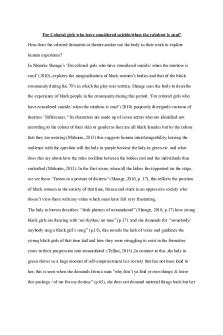GLPH271 Discussion Post 5 PDF

| Title | GLPH271 Discussion Post 5 |
|---|---|
| Author | julia Aguiar |
| Course | Global Health |
| Institution | Queen's University |
| Pages | 2 |
| File Size | 63.4 KB |
| File Type | |
| Total Downloads | 9 |
| Total Views | 148 |
Summary
Use the GBD compare tool to investigate a disease of your choice. Look at how the disease pattern changes over time, location, age, and/or gender. You may also choose to describe differences depending on whether you are looking at DALYs, death rates, or Years of Life Disabled.
Post a one-parag...
Description
GLPH271 Discussion Post #5 GBD Comparison
Use the GBD compare tool to investigate a disease of your choice. Look at how the disease pattern changes over time, location, age, and/or gender. You may also choose to describe differences depending on whether you are looking at DALYs, death rates, or Years of Life Disabled. Post a one-paragraph summary of your findings to the Discussion Board, GBD Compare. Feel free to include an image of your findings in the post by clicking on the “Insert Image” option of the message composition toolbar (second icon on the left-hand side). Read and respond to the GBD compare summary of two of your peers.
The disease that I have chosen to investigate is neurological disorders which includes Alzheimer’s, dementia, Parkinson’s and other related diseases. Attached above are images which correspond to comparison of deaths per 100 000. The first image represents deaths within the age group of 15-49 and the second represents the age group from 70 and older. It can clearly be seen that the number of deaths related to these diseases increases as the population gets older, especially in countries such as Japan and many Western European countries including France. Japan in particular reported deaths to be about 1.22/100 000 in the younger age group with a drastic increase to nearly 662/100 000 with groups older than 70. As well, although Japan has the highest life expectancy at birth among the Organisation for Economic Co-operation and Development (OECD) countries, it also has the highest dementia prevalence (Fuwaka, 2018). Overall, most countries experience higher mortality due to neurological disorders in the older age groups. These two images show clear evidence of the change in our neurological makeup as we age and reinforce the idea that over the age of 60, normal nerve conductions begin to deteriorate (Stanton, 2011). As well, many conditions that commonly occur in old age such as malnutrition and malabsorption may cause deficiency of essential vitamins and minerals which are necessary for brain metabolism and can lead to vascular damage, increasing the risk of neurological disorders in elderly populations (Kowalska et al., 2017).
Fuwaka , T. (2018). Take a look at the recent articles. Prevalence of dementia among the elderly population in Japan. Retrieved October 6, 2021, from https://www.oatext.com/prevalenceof-dementia-among-the-elderly-population-in-japan.php#Article_Info. Kowalska, M., Owecki, M., Prendecki, M., Wize, K., Nowakowska, J., Kozubski, W., & Dorszewska, M. L. andJ. (2017, August 30). Aging and neurological diseases. IntechOpen. Retrieved October 6, 2021, from https://www.intechopen.com/chapters/55869.
Stanton, B. R. (2011, February). The neurology of old age. Clinical medicine (London, England). Retrieved October 6, 2021, from https://www.ncbi.nlm.nih.gov/pmc/articles/PMC5873804/....
Similar Free PDFs

GLPH271 Discussion Post 5
- 2 Pages

5-1 discussion post
- 3 Pages

Discussion Post
- 2 Pages

Discussion Post
- 1 Pages

CS 2205 Unit 5 Discussion Post
- 2 Pages

Week 3 - discussion post
- 1 Pages

Black Panther Discussion Post
- 1 Pages

NEUR3000 Discussion post 7
- 2 Pages

Discussion Post Module 3
- 2 Pages

Module 9 - Discussion Post
- 2 Pages

Example-Discussion Post
- 3 Pages

discussion post dis
- 2 Pages

DQ 1 - Discussion post
- 1 Pages
Popular Institutions
- Tinajero National High School - Annex
- Politeknik Caltex Riau
- Yokohama City University
- SGT University
- University of Al-Qadisiyah
- Divine Word College of Vigan
- Techniek College Rotterdam
- Universidade de Santiago
- Universiti Teknologi MARA Cawangan Johor Kampus Pasir Gudang
- Poltekkes Kemenkes Yogyakarta
- Baguio City National High School
- Colegio san marcos
- preparatoria uno
- Centro de Bachillerato Tecnológico Industrial y de Servicios No. 107
- Dalian Maritime University
- Quang Trung Secondary School
- Colegio Tecnológico en Informática
- Corporación Regional de Educación Superior
- Grupo CEDVA
- Dar Al Uloom University
- Centro de Estudios Preuniversitarios de la Universidad Nacional de Ingeniería
- 上智大学
- Aakash International School, Nuna Majara
- San Felipe Neri Catholic School
- Kang Chiao International School - New Taipei City
- Misamis Occidental National High School
- Institución Educativa Escuela Normal Juan Ladrilleros
- Kolehiyo ng Pantukan
- Batanes State College
- Instituto Continental
- Sekolah Menengah Kejuruan Kesehatan Kaltara (Tarakan)
- Colegio de La Inmaculada Concepcion - Cebu


